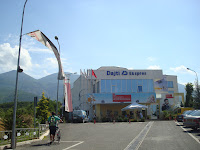 I named this blog “Sunshine and Albania” shortly after arriving. It was early July, summer was popping, and everything was bright and new to me. Day after day of clear blue skies. Both the climate charts and the residents agree that Albania enjoys a remarkably high average of sunlight.
I named this blog “Sunshine and Albania” shortly after arriving. It was early July, summer was popping, and everything was bright and new to me. Day after day of clear blue skies. Both the climate charts and the residents agree that Albania enjoys a remarkably high average of sunlight. Large doses of sunshine are good for tourism promoters. In July and August, I saw everything through rosy-lensed sunglasses. Colors looked photoshopped. I couldn’t figure out why everyone in Europe hadn’t booked their flight or ferry to Albania already.
Clouds
Now it’s September, and things are changing. As clouds roll in, the sunny outlook is getting harder to maintain. We’ve already seen about eight wet days this month, including last Friday when I decided to bike from Tirana to Berat.
I met a traveler named Brody (also a Denver native) who is touring Mediterranean Europe and the Middle East by bicycle. Somehow I convinced him that I could keep up with him on his next stretch of road from Tirana to Berat in a day. “It’s around 70 miles,” he warned me. “Around 70 kilometers” is what I decided to hear. That was only like 40 something miles, right? “No problem,” I told him. “Let’s do this.” Forecast: cloudy.
 Potholes
PotholesThe next morning, the sky was solid gray as we made our way onto the patchy highway that was still dark and puddled from rain the day before. Traffic was loudly misbehaving as usual, and the pollution was forming its own haze.
Without a need for sunglasses, I began to see my surroundings for what they really were: a lunar landscape of concrete and potholes. Bad ones. Brody, who has been living on a bicycle for awhile now, said that these were some of the worst road conditions he’d seen yet on his trip. I slid and tumbled down twice.
 Lavazh - the car wash
Lavazh - the car washBy the time we reached a restaurant for lunch, I was so mud-splattered that the waiter didn’t even let me come in. He pointed me to the lavazh -- the car wash.
In Albania, the solution to bad, dirty roads and a suspicious abundance of Mercedes Benzes is a car wash every 100 meters.
I wandered in and found the hose gun. It was actually really fun to get my legs and bike hosed down with high pressure.
Berat
After about 6 hours of pedaling, I was slowing down. Brody coached me along with a countdown announcement of my first “metric century” when we reached the 100 km mark. Sometimes he’d start literally pushing me along from his own bike. Finally, we reached the small city of Berat. 120 km total.
The historical center of Berat has earned it designation as a UNESCO World Heritage Site. Hillside residences are uniformly whitewashed with big frame windows that peer outward. I didn’t count them, but supposedly Berat is the “city of a thousand windows.”
 We climbed to the Berat castle ruins above the city just in time for golden hour lighting. The sun finally made a brief appearance just to illuminate the clouds for great sunset. I just watched and wondered why everybody in Europe hasn’t booked their flight or ferry to Albania already.
We climbed to the Berat castle ruins above the city just in time for golden hour lighting. The sun finally made a brief appearance just to illuminate the clouds for great sunset. I just watched and wondered why everybody in Europe hasn’t booked their flight or ferry to Albania already. The forecast
For the avid bike tourist, the Albanian stretch of their trip is a rough but doable challenge. For the less experienced, it is still too much of an “adventure tour.” The roads have a ways to go before companies like Outdoor Albania can package this route. But, given the rate of change in Albania, five years from now might be an entirely different story. Long-term forecast: sunny.












